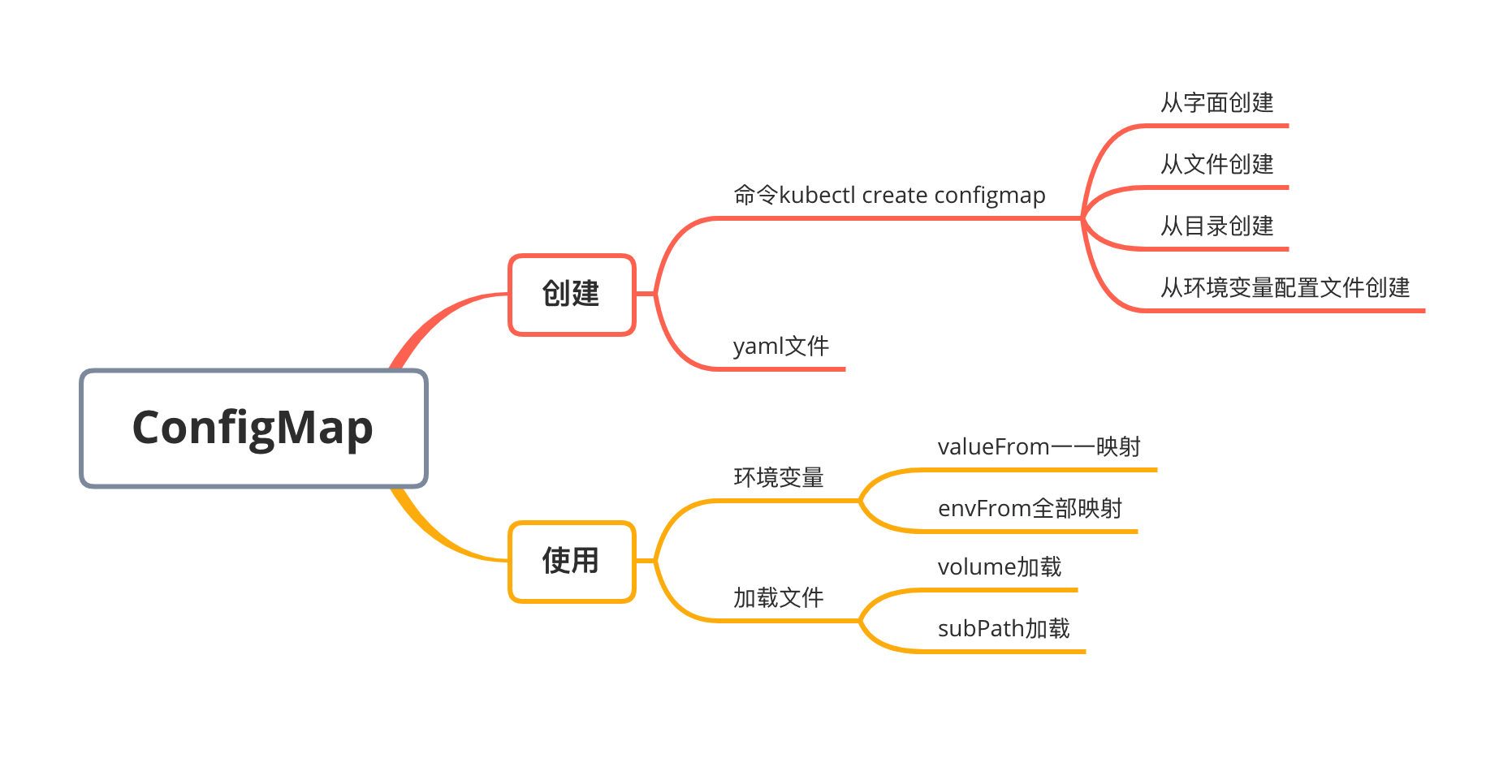k8s之configmap应用
前言
ConfgMap主要用于为容器中的应用提供配置数据,以达到应用程序的配置内容定制化。
ConfigMap的本质上是键值对,基于键值对将应用的配置信息传递给Pod。
一、配置方法

按大类可分为两种方式,细分共有五种方式:
1、kubectl create configmap创建
- 通过命令行参数字面直接创建
- 通过指定文件创建
- 通过指定目录创建
- 通过指定环境变量配置文件创建
2、yaml文件创建
二、创建configmap
1、基于命令创建configmap
通过参数--from-literal直接指定键值对。这种方式比较适用于临时测试使用,而且不适合配置很多的情况
root@k8s-master01:~# kubectl create configmap demoapp-cfg --from-literal=listen.port=8080 --from-literal=listen.address='127.0.0.1'
configmap/demoapp-cfg created
root@k8s-master01:~# kubectl get cm
NAME DATA AGE
demoapp-cfg 2 7s
kube-root-ca.crt 1 35h
root@k8s-master01:~# kubectl get cm demoapp-cfg -oyaml
apiVersion: v1
data:
listen.address: 127.0.0.1
listen.port: "8080"
kind: ConfigMap
metadata:
creationTimestamp: "2024-01-20T00:55:59Z"
name: demoapp-cfg
namespace: default
resourceVersion: "273698"
uid: 1df08044-46c7-4672-a328-7f81174e27d8
2、基于文件创建nginx-configmap
通过参数--from-file来指定文件。
准备nginx配置文件
root@k8s-master01:~/learning-k8s/examples/configmaps_and_secrets# pwd
/root/learning-k8s/examples/configmaps_and_secrets
root@k8s-master01:~/learning-k8s/examples/configmaps_and_secrets# ls nginx-conf.d/
myserver-gzip.cfg myserver-status.cfg myserver.conf
root@k8s-master01:~/learning-k8s/examples/configmaps_and_secrets#
root@k8s-master01:~/learning-k8s/examples/configmaps_and_secrets# ls nginx-conf.d/
myserver-gzip.cfg myserver-status.cfg myserver.conf
root@k8s-master01:~/learning-k8s/examples/configmaps_and_secrets# cat nginx-conf.d/myserver-gzip.cfg
gzip on;
gzip_comp_level 5;
gzip_proxied expired no-cache no-store private auth;
gzip_types text/plain text/css application/xml text/javascript;
root@k8s-master01:~/learning-k8s/examples/configmaps_and_secrets# cat nginx-conf.d/myserver-status.cfg
location /nginx-status {
stub_status on;
access_log off;
}
root@k8s-master01:~/learning-k8s/examples/configmaps_and_secrets# cat nginx-conf.d/myserver.conf
server {
listen 8080;
server_name www.ik8s.io;
include /etc/nginx/conf.d/myserver-*.cfg;
location / {
root /usr/share/nginx/html;
}
}
root@k8s-master01:~/learning-k8s/examples/configmaps_and_secrets# kubectl create configmap nginx-cfg --from-file=./nginx-conf.d/myserver.conf --from-file=./nginx-conf.d/myserver-status.cfg --from-file=./nginx-conf.d/myserver-gzip.cfg --dry-run=client -oyaml
apiVersion: v1
data:
myserver-gzip.cfg: |
gzip on;
gzip_comp_level 5;
gzip_proxied expired no-cache no-store private auth;
gzip_types text/plain text/css application/xml text/javascript;
myserver-status.cfg: |
location /nginx-status {
stub_status on;
access_log off;
}
myserver.conf: |
server {
listen 8080;
server_name www.ik8s.io;
include /etc/nginx/conf.d/myserver-*.cfg;
location / {
root /usr/share/nginx/html;
}
}
kind: ConfigMap
metadata:
creationTimestamp: null
name: nginx-cfg
3、基于目录创建
上一种方式没有太大差别,只是--from-file后面的参数是目录,而不是文件。
root@k8s-master01:~/learning-k8s/examples/configmaps_and_secrets# kubectl create configmap nginx-cfg --from-file=./nginx-conf.d/ --dry-run=client -oyaml
apiVersion: v1
data:
myserver-gzip.cfg: |
gzip on;
gzip_comp_level 5;
gzip_proxied expired no-cache no-store private auth;
gzip_types text/plain text/css application/xml text/javascript;
myserver-status.cfg: |
location /nginx-status {
stub_status on;
access_log off;
}
myserver.conf: |
server {
listen 8080;
server_name www.ik8s.io;
include /etc/nginx/conf.d/myserver-*.cfg;
location / {
root /usr/share/nginx/html;
}
}
kind: ConfigMap
metadata:
creationTimestamp: null
name: nginx-cfg
4、从环境变量配置文件创建
这种方式如之前的从文件创建很不一样。它的(key, value)不是(文件名,文件内容),而是文件中一个个的配置。
配置文件pkslow.env内容如下:
PKSLOW_NAME=Larry
PKSLOW_AGE=18
PKSLOW_WEBSITE=www.pkslow.com
创建命令如下:
$ kubectl create configmap pkslow-env --from-env-file=pkslow.env
查看内容如下:
kubectl get configmaps pkslow-env -o yaml
apiVersion: v1
data:
PKSLOW_AGE: "18"
PKSLOW_NAME: Larry
PKSLOW_WEBSITE: www.pkslow.com
kind: ConfigMap
metadata:
name: pkslow-env
namespace: default
5、通过yaml文件创建
通过yaml文件创建就很常规了,跟普通的kubernetes资源创建没有什么区别。
apiVersion: v1
kind: ConfigMap
metadata:
name: pkslow-yaml
data:
PKSLOW_AGE: "18"
PKSLOW_NAME: Larry
PKSLOW_WEBSITE: www.pkslow.com
application-uat.yaml: |-
server:
port: 8080
pkslow:
name: LarryDpk
age: 20
webSite: https://www.pkslow.com
application.yaml: |-
server:
port: 8080
pkslow:
name: Larry
age: 18
webSite: www.pkslow.com
再通过以下文件创建:
$ kubectl apply -f configmap.yaml
三、在Pod上使用ConfigMap
在Pod中使用ConfigMap有以下四种方式
- 在容器命令和参数内;
- 容器的环境变量;
- 在只读卷里面添加一个文件,让应用来读取;
- 编写代码在 Pod 中运行,使用 Kubernetes API 来读取 ConfigMap;
其中第1种和第2种方式类似,只是启动命令添加环境变量,所以还是要把ConfigMap映射为容器的环境变量。第4种方式要访问API,可以使用相关的库,如Spring Cloud Kubernetes.
-
环境变量
将configmap对象上的某key的值赋值给(valueFrom)指定的环境变量,不支持动态加载。 -
卷
在Pod上基于configMap卷插件引用configmap对象,支持动态加载。
在Container上挂载configMap卷
每个kv会分别被映射为一个文件,文件名同key,value将成为文件内容
注意:
- 通过环境变量引用在Pod创建的时候完成赋值,configmap更改不生效。
- 通过卷挂载,基于卷引用,configmap可以动态加载。
3.1、通过环境变量引用configmap
把ConfigMap的值映射到环境变量,主要有两种方式,valueFrom和envFrom。
3.1.1 valueFrom一一映射
通过valueFrom来配置环境变量,Pod的环境变量名与ConfigMap不必相同。
root@k8s-master01:~/learning-k8s/examples/configmaps_and_secrets# cat configmaps-env-demo.yaml
---
apiVersion: v1
kind: ConfigMap
metadata:
name: demoapp-config
namespace: default
data:
demoapp.port: "8080"
demoapp.host: 127.0.0.1
---
apiVersion: v1
kind: Pod
metadata:
name: configmaps-env-demo
namespace: default
spec:
containers:
- image: ikubernetes/demoapp:v1.0
name: demoapp
env:
- name: PORT
valueFrom:
configMapKeyRef:
name: demoapp-config
key: demoapp.port
optional: false
- name: HOST
valueFrom:
configMapKeyRef:
name: demoapp-config
key: demoapp.host
optional: true
root@k8s-master01:~/learning-k8s/examples/configmaps_and_secrets# kubectl apply -f configmaps-env-demo.yaml
configmap/demoapp-config created
pod/configmaps-env-demo created
root@k8s-master01:~/learning-k8s/examples/configmaps_and_secrets# kubectl get cm
NAME DATA AGE
demoapp-cfg 2 24m
demoapp-config 2 6s
kube-root-ca.crt 1 35h
root@k8s-master01:~/learning-k8s/examples/configmaps_and_secrets# kubectl get pod
NAME READY STATUS RESTARTS AGE
configmaps-env-demo 1/1 Running 0 7m27s
3.1.2 envFrom全部映射
通过envFrom会把ConfigMap的所有键值对都映射到Pod的环境变量中去。
apiVersion: v1
kind: Pod
metadata:
name: pkslow-env-env-from
spec:
containers:
- name: test-container
image: busybox
command: [ "/bin/sh", "-c", "env" ]
envFrom:
- configMapRef:
name: pkslow-yaml
restartPolicy: Never
查看环境变量如下:
$ kubectl logs -f pkslow-env-env-from
PKSLOW_WEBSITE=www.pkslow.com
PKSLOW_AGE=18
PKSLOW_NAME=Larry
application.yaml=server:
port: 8080
pkslow:
name: Larry
age: 18
webSite: www.pkslow.com
application-uat.yaml=server:
port: 8080
pkslow:
name: LarryDpk
age: 20
webSite: https://www.pkslow.com
显然看起来这种方式更简便,不用每个环境变量都配一遍,但它可能会带来脏数据,就看怎么使用了。
3.2、通过卷挂载configmap
可以通过volume的方式把ConfigMap加载进Pod。
- 创建configmap
root@k8s-master01:~/learning-k8s/examples/configmaps_and_secrets# kubectl create configmap nginx-config-files --from-file=./nginx-conf.d/
configmap/nginx-config-files created
root@k8s-master01:~/learning-k8s/examples/configmaps_and_secrets# kubectl get cm
NAME DATA AGE
demoapp-cfg 2 38m
demoapp-config 2 13m
kube-root-ca.crt 1 36h
nginx-config-files 3 6s
- 创建nginx pod将configmap作为配置文件挂载到指定目录下
root@k8s-master01:~/learning-k8s/examples/configmaps_and_secrets# cat configmaps-volume-demo.yaml
apiVersion: v1
kind: Pod
metadata:
name: configmaps-volume-demo
namespace: default
spec:
containers:
- image: nginx:1.22
name: nginx-server
volumeMounts:
- name: ngxconfs
mountPath: /etc/nginx/conf.d/
readOnly: true
volumes:
- name: ngxconfs
configMap:
name: nginx-config-files
optional: false
root@k8s-master01:~/learning-k8s/examples/configmaps_and_secrets# kubectl apply -f configmaps-volume-demo.yaml
pod/configmaps-volume-demo created
root@k8s-master01:~/learning-k8s/examples/configmaps_and_secrets# kubectl get pod
NAME READY STATUS RESTARTS AGE
configmaps-env-demo 1/1 Running 0 23m
configmaps-volume-demo 1/1 Running 0 5m16s
root@k8s-master01:~/learning-k8s/examples/configmaps_and_secrets# kubectl exec -it configmaps-volume-demo bash
kubectl exec [POD] [COMMAND] is DEPRECATED and will be removed in a future version. Use kubectl exec [POD] -- [COMMAND] instead.
root@configmaps-volume-demo:/# ls /etc/nginx/conf.d/
myserver-gzip.cfg myserver-status.cfg myserver.conf
root@configmaps-volume-demo:/# nginx -T
...
# configuration file /etc/nginx/conf.d/myserver.conf:
server {
listen 8080;
server_name www.ik8s.io;
include /etc/nginx/conf.d/myserver-*.cfg;
location / {
root /usr/share/nginx/html;
}
}
# configuration file /etc/nginx/conf.d/myserver-gzip.cfg:
gzip on;
gzip_comp_level 5;
gzip_proxied expired no-cache no-store private auth;
gzip_types text/plain text/css application/xml text/javascript;
# configuration file /etc/nginx/conf.d/myserver-status.cfg:
location /nginx-status {
stub_status on;
access_log off;
}
...
- 访问nginx服务
root@k8s-master01:~/learning-k8s/examples/configmaps_and_secrets# kubectl get pod -o wide
NAME READY STATUS RESTARTS AGE IP NODE NOMINATED NODE READINESS GATES
configmaps-env-demo 1/1 Running 0 28m 10.244.2.24 k8s-node01 <none> <none>
configmaps-volume-demo 1/1 Running 0 10m 10.244.2.25 k8s-node01 <none> <none>
root@k8s-master01:~/learning-k8s/examples/configmaps_and_secrets# curl 10.244.2.25:8080
<!DOCTYPE html>
<html>
<head>
<title>Welcome to nginx!</title>
<style>
html { color-scheme: light dark; }
body { width: 35em; margin: 0 auto;
font-family: Tahoma, Verdana, Arial, sans-serif; }
</style>
</head>
<body>
<h1>Welcome to nginx!</h1>
<p>If you see this page, the nginx web server is successfully installed and
working. Further configuration is required.</p>
<p>For online documentation and support please refer to
<a href="http://nginx.org/">nginx.org</a>.<br/>
Commercial support is available at
<a href="http://nginx.com/">nginx.com</a>.</p>
<p><em>Thank you for using nginx.</em></p>
</body>
</html>
好文推荐





【推荐】国内首个AI IDE,深度理解中文开发场景,立即下载体验Trae
【推荐】编程新体验,更懂你的AI,立即体验豆包MarsCode编程助手
【推荐】抖音旗下AI助手豆包,你的智能百科全书,全免费不限次数
【推荐】轻量又高性能的 SSH 工具 IShell:AI 加持,快人一步
· 被坑几百块钱后,我竟然真的恢复了删除的微信聊天记录!
· 没有Manus邀请码?试试免邀请码的MGX或者开源的OpenManus吧
· 【自荐】一款简洁、开源的在线白板工具 Drawnix
· 园子的第一款AI主题卫衣上架——"HELLO! HOW CAN I ASSIST YOU TODAY
· Docker 太简单,K8s 太复杂?w7panel 让容器管理更轻松!